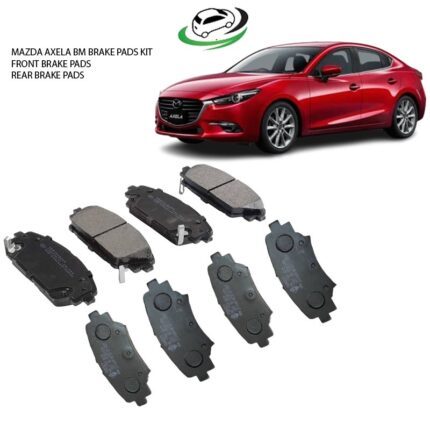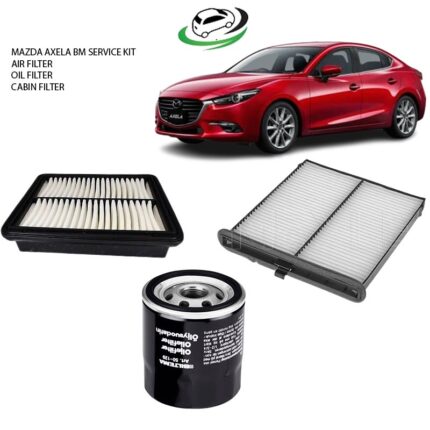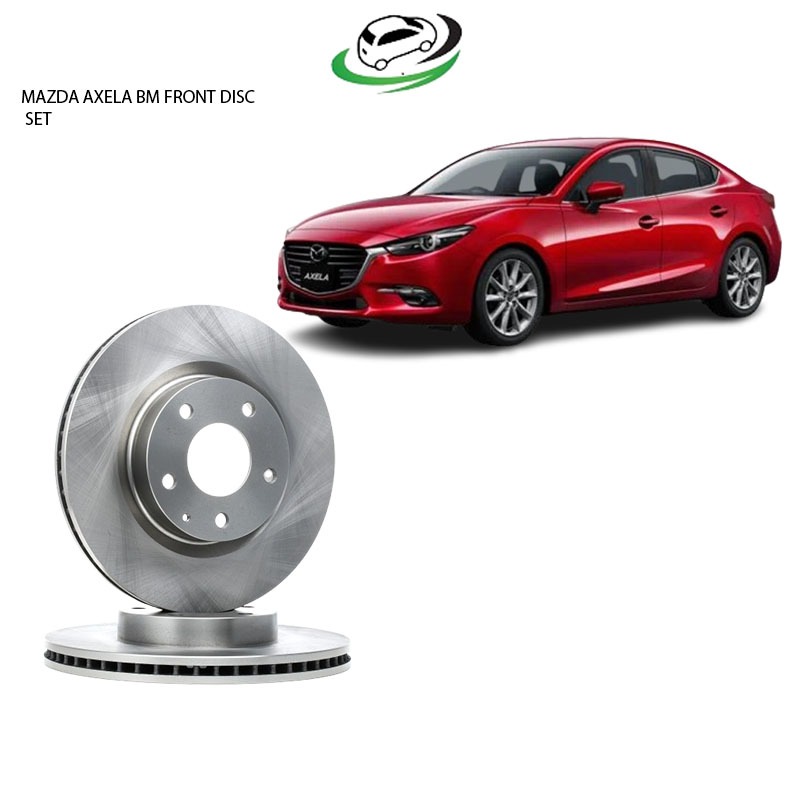-7%
Get Mazda Axela BM Front Brake Disc Assy B45G-33-251A
The front brake disc assembly is a crucial component in a vehicle’s braking system, playing a vital role in ensuring safe and effective deceleration. It works in conjunction with the brake pads and calipers to create the friction necessary to slow down or stop the vehicle. While all parts of the braking system are important, the brake disc (also known as the rotor) is the surface against which the brake pads press, and without it, the vehicle’s stopping power would be significantly reduced.
In this detailed guide, we’ll explore the front brake disc assembly, its function, components, types, signs of wear, maintenance, and replacement.
Components of the Front Brake Disc Assembly
The front brake disc assembly typically consists of three main components:
- Brake Disc (Rotor):
- The brake disc is the central component of the assembly. It is a circular metal disc attached to the wheel hub that rotates along with the wheel. When the brake pedal is applied, the brake pads clamp onto the disc to create friction, causing the vehicle to decelerate.
- Brake Pads:
- While not technically part of the brake disc, the pads are essential to the operation of the disc. They are made from friction materials and are pressed against the brake disc to create the necessary stopping force.
- Brake Caliper:
- The brake caliper houses the brake pads and applies the force necessary to press the pads against the disc. It contains a piston that moves when brake fluid is forced into the caliper, pushing the pads toward the disc.
Function of the Front Brake Disc Assembly
The primary function of the front brake disc assembly is to convert the kinetic energy of a moving vehicle into heat energy through friction. Here’s a breakdown of how it works:
- Kinetic Energy Conversion:
- When you press the brake pedal, brake fluid is pushed through the brake lines into the calipers. This pressure forces the caliper pistons to push the brake pads against the spinning brake disc.
- The friction between the brake pads and the disc slows the wheel’s rotation, converting the vehicle’s kinetic energy into heat.
- Heat Dissipation:
- Since braking generates significant heat, the brake disc is designed to dissipate heat quickly to avoid overheating and brake fade. Vented brake discs (which have small gaps between the two friction surfaces) are particularly effective at heat dissipation.
- Vehicle Stability and Control:
- The brake disc assembly ensures that the vehicle slows down smoothly and safely. Front discs, in particular, handle most of the braking force because of the weight transfer to the front during braking. This makes the front brake disc assembly critical for vehicle stability and stopping power.
Types of Brake Discs
There are several types of brake discs available, each designed for different applications and driving conditions:
- Solid Brake Discs:
- Solid brake discs are simple, solid metal discs used in smaller, lighter vehicles. They are less expensive but less effective at heat dissipation compared to vented or drilled discs.
- Vented Brake Discs:
- Vented brake discs are the most common type used in modern vehicles. They consist of two discs with a gap in between, allowing air to flow through and cool the brakes more effectively. These discs are ideal for high-speed driving and vehicles that undergo frequent braking.
- Drilled Brake Discs:
- Drilled brake discs have holes drilled into them to help with heat dissipation and water evacuation. They are often used in performance vehicles or in wet driving conditions. The holes also reduce the weight of the disc, improving vehicle handling.
- Slotted Brake Discs:
- Slotted brake discs feature grooves along the surface of the disc, which help remove debris, gases, and water from between the disc and the brake pad. They offer better braking performance, especially in aggressive driving or racing applications.
- Drilled and Slotted Discs:
- Combining the benefits of both drilled and slotted discs, these are designed for maximum performance and heat dissipation. However, they are typically more expensive and mainly used in high-performance vehicles.
Signs of Worn Front Brake Discs
Over time, brake discs can wear out or become damaged. Recognizing the signs of worn brake discs is important to ensure your vehicle’s braking system remains effective. Here are the common symptoms:
- Vibration or Pulsation When Braking:
- If you feel a vibration in the brake pedal or steering wheel when applying the brakes, it could be a sign that the brake disc is warped or uneven. Warping can occur due to excessive heat buildup or improper installation.
- Squealing or Grinding Noise:
- A high-pitched squealing noise when braking may indicate that the brake pads are worn out and the metal backing plate is coming into contact with the disc. Grinding noises, on the other hand, suggest that the disc is already being damaged by metal-to-metal contact.
- Grooved or Scored Disc Surface:
- Visually inspect the brake disc for grooves or scoring on the surface. These imperfections can reduce braking efficiency and are often caused by debris caught between the brake pad and the disc or by worn brake pads.
- Reduced Braking Performance:
- If you notice that your vehicle takes longer to stop or the brakes feel less responsive, it could be a sign that the brake discs are worn or damaged.
- Blue Tinge or Heat Spots:
- Excessive heat can cause visible discoloration on the brake disc, often appearing as a blue or dark purple tint. This is a sign of overheating and can lead to brake fade, reducing braking performance.
Maintenance and Care for Front Brake Discs
Proper maintenance of the front brake disc assembly ensures optimal performance and extends its lifespan. Here are some key maintenance tips:
- Regular Inspections:
- Brake discs should be inspected during routine maintenance or at least every 10,000 to 12,000 miles. Look for any signs of wear, warping, or grooving. You should also check the thickness of the brake discs, as they wear down over time.
- Brake Pad Replacement:
- Brake pads should be replaced before they wear down completely. If the pads are allowed to wear out, they can damage the brake disc, leading to costly repairs.
- Proper Torque Settings:
- Ensure that the brake disc is installed with the proper torque settings to prevent warping. Over-tightening the lug nuts can cause the disc to warp over time.
- Brake Fluid Maintenance:
- Brake fluid should be checked and replaced as needed. Contaminated or low brake fluid can affect the performance of the brake caliper, leading to uneven pressure on the brake pads and discs.
- Avoid Excessive Braking:
- Heavy braking, particularly during high-speed driving, can generate excessive heat and lead to brake disc warping or cracking. Use engine braking when possible to reduce the load on the braking system.
Replacement of Front Brake Discs
Front brake discs eventually wear out and need replacement. Here’s a general overview of the replacement process:
- Preparation:
- The vehicle is lifted, and the wheels are removed to access the brake assembly. Ensure that the vehicle is stable, using jack stands to support it.
- Remove the Caliper:
- The brake caliper is removed to access the brake disc. You may need to secure the caliper to prevent it from hanging by the brake lines, which could cause damage.
- Remove the Old Brake Disc:
- Once the caliper is out of the way, the old brake disc can be removed from the wheel hub. Some discs may be secured with screws or may require gentle tapping with a mallet to remove due to rust or corrosion.
- Inspect and Clean the Hub:
- Before installing the new brake disc, inspect the wheel hub for any debris or rust. Use a wire brush or brake cleaner to clean the hub to ensure the new disc sits flush and doesn’t cause vibrations.
- Install the New Brake Disc:
- The new brake disc is installed onto the wheel hub. Ensure it is aligned correctly and secured in place. In some cases, you may need to use screws to hold the disc in position.
- Reattach the Caliper and Brake Pads:
- Once the new brake disc is installed, the brake caliper and pads are reattached. Check that everything is secured tightly and that the brake pads are correctly seated.
- Test the Brakes:
- After installation, press the brake pedal multiple times to ensure that the caliper pistons are properly engaged with the new brake disc. Take the vehicle for a test drive to verify that the braking performance is smooth and consistent.
Conclusion
The front brake disc assembly is a critical part of your vehicle’s braking system, responsible for providing the necessary friction to slow down or stop the vehicle. Understanding the components, types, and signs of wear helps ensure that your brake discs are well-maintained and performing optimally. Regular inspections, proper maintenance, and timely replacements of worn components are essential to keeping your vehicle safe and roadworthy.
Follow us on Facebook for more parts.




Reviews
Clear filtersThere are no reviews yet.